It looks like you're using an Ad Blocker.
Please white-list or disable AboveTopSecret.com in your ad-blocking tool.
Thank you.
Some features of ATS will be disabled while you continue to use an ad-blocker.
share:
Omega, those last pictures you just posted are very interesting to say the least. I will say, while the idea of some sort of organized flight (or
something similar) is fascinating, I don't think there is anyway to prove that is what were looking at. The other picture, however, is much more
interesting. It really does look like some sort of tower. Although in the closer picture, it doesn't really look that way anymore. It's just so hard
to tell anything with these pictures. Very interesting either way though.
Ohhhhhhhhhhh, By the way I would like to know what the element "HELIUM 3" means to you groovey people
Well, as I was getting interested in my initial thoughts of the moon being mined for resources, I ran across this article about the application's of certain elementnt's and how they would be able to contribute to the application's of mining the moon and for what reason's it would be viable to do so. There has been a lot studied theories as to what the 3HE/4HE implication's would be, for as far as hte scientist's know, the Earth has it's own Georeactor in the core of the earth already producing the afore mentioned element's. The only thing to this inquiry that should stand out for the possible implication's of mining the moon are that the Earth's "Georeactor" is in it's final phase, (With out definate dates of total consumption) is radically going tochange the Earth as we know it. This is a very "beginner's" read of what they would have to realize that there is strong implication's to the fact's of this happening in a relatively short period of time, but is left to be acknowledge as truly "Inevitable" occurance for the Earth's Elemental Dynamic's.
nuclearplanet.com...
As for the implication's of being able retrieve this element from the moon's surface, science's would vastly be accelerated forward with possible application's of HE3 in abundance. Here is a site that give's the implication factor's for the accessability to HE3 and what it would create as a new kind of "Nanoscience" technologies.
“I am convinced that the unusual magnetism observed by the Florida group is due to a combination of the small number of atoms present and the very large ratio of surface atoms to total atoms,” Ihas said. “This effect is the essence of nanoscience, and just the beginning of developments which will quickly impact our everyday lives, which are now so dependent on materials development.”
Though the site in discussion deals with the implication's of "Magnetic Properties", the insight is in the fact that there could be litterally a lot of ways to implicate it in everything from Medical to Computer technologies.
news.ufl.edu...
There is quite an explanation of how Tritium and 3HE(A stable element produced by Tritium) is used in the application's of being able to measure radioactivity in stagnenent water. The study was achieved in Alaska for there fresh water reserves to see if the cause and effect's of nuclear fall out from previous test of the bomb's in the past. It was quite a long document and it was basically for that one particular study. I decided not to post the factual find's for these experiments but wanted to acknowledge to you all that there are many versatile applications for the 3HE use's.
As we already are aware of that 3HE cas a high magnetism ratio and with that in mind, can be put forth in so many application's that it starts from being able to practically cover every aspect of the science community with it's ability to be versatile for many important and Nanoscience technologies that we have only began to explore or understand, with these new practicalities, science's could evolve much faster than what was first thought of the expansion's of our knowledge. Computer's are going to be faster with more memory and the thing's that come from this moddest element are far reaching. Here is an exert from a study of what the "Superfluidity" of 3HE test's are openeing the door's for a much more acceptable and unmeasurable scientifically evolving technologie's.
December 13, 1996 by Phillip F. Schewe and Ben Stein
HELIUM-3 CAN REMAIN SUPERFLUID IN AEROGEL , albeit at a lower temperature. When He-3 was injected into a sample of aerogel, a wispy glass gel with a density not that much greater than air, some expected the gel's filaments to disrupt entirely the pairing of He-3 atoms necessary for superfluidity. This didn't happen. A new surprise is the fact that an applied magnetic field does have an effect on superfluidity in the aerogel; it depresses the superfluid transition temperature further (Sprague et al., Physical Review Letters, 25 November). Research on superfluid He-3 in aerogel may have implications for the study of superconductivity since the pairing of He-3 atoms in superfluids is analogous to electron pairing (the BCS mechanism) in some superconductors. (Science News, 7 December 1996.)
Source:www.aip.org...
hers another from "Cornell University" pretty much just authenticates the apparent element at hand. "Nothing wrong with a little back-up".
www.news.cornell.edu...
I have went to this next website and it is self explanatory as to what it is, Omega85, "YOU HAVE GOT TO CHECK THIS OUT MAN!!", you may have to 'Cut ' and 'Paste' to the address bar, but much worht the effort. It is a very detailed description of the implication's of mining the moon's resource's with cost's,materials
and other informative stuff. I could not pull a "Properties" check to display this find, but once you get to the web page, you are going to fall backwards with all the answer's to this topic of mining the moon and it's practicality of why to mine it.
ECONOMIC GEOLOGY OF LUNAR HELIUM-3File Format: Microsoft Powerpoint - View as HTML
University of Wisconsin-Madison. 11. MINING IMPLICATIONS. AT RECOVERABLE GRADE OF 20 PPB,. 100 KG HELIUM-3 REQUIRES MINING. 2 KM2 TO DEPTH OF 3 METERS AND ...
www.higp.hawaii.edu/srr/SRR-VI-presentations/ Schmitt-helium_in_regolith_SRR6.ppt - Similar pages
Here is another exert dealing with the "Possibility" of using 3HE as a clean burning usable fuel for the future, "Good and interesting read."
As an example, Gerald Kulcinski, Harrison Schmitt, and co-workers have proposed the use of the rare helium-3 from the Moon as a fuel for clean-burning fusion reactors.
www.house.gov...
Well, that is quite a bit of informatin of what I think of this element, I hope that this is as informative for you as it was for me, it makes for a good, realistic and practical read for the topic of why and how the moon could serve us, and of course "Why would we (USA) have a base on the moon anyways?" Theorists.
Did you guy's realize that there is another thread created on the forums that are doing research themselve's? It is titled "Bush's moon Base
2015" or something like that. There is more just chit-chat on the thread, but as I was reading throuhg it, I stumbled on this NASA released interview
with an astronaut that confirms he seen "Existing Bases on the moon", "Could this be some kind of disinformation plight , or is it the real
deal?"
I think this is for the "Anxietydisorders" realm of acknowledgement. I went to the site where the story is and it is very convencing interview to say the least.
www.subversiveelement.com...
Just thought I would let you guy's know that there seem's to be possible "Competition" on the threads for this topic..
I think this is for the "Anxietydisorders" realm of acknowledgement. I went to the site where the story is and it is very convencing interview to say the least.
www.subversiveelement.com...
Just thought I would let you guy's know that there seem's to be possible "Competition" on the threads for this topic..
This is a pic that I came across that has an image of a structure that look's very similar to a bridge. There is an arrow locating where to look for
this anomaly. The time looking at this oicture, I found an unusual amount of anomalies around it in every direction, if you concentrate your view to
the center of the pic, you will see a circular object and in the center of it there is a triangular shape. To me this look's like some kind of
craft, delta wing's and stabilizing tail. The , if you direct your attention to the top of the 'Craft area' you will see an object that look's
hauntingly familiar to an observation tower with a lookout hole through the top of it. To the bottom left of the pic. there is something that look's
somewhat semi-circular, let your eye's follow it and you can see distinct feature's that look like docking bay door's, not just one, but several of
them following the same design and pattern at approximately the same size all along the 'Cat-walk' or 'Trellace walk' area. this is a very nice
picture to say the least and I would love to hear some of your guy's feedback on what you can see in it. It is basically a small city with a number
of anomalies. "Enjoy."
i74.photobucket.com...
i74.photobucket.com...
Hello all,
Allred that is a very interesting pic!!
Do u know what part of the moon that is on?
It would be good to get some coordinates.
I am just havin a look around at the moment but i will post some info soon.
Omega
Allred that is a very interesting pic!!
Do u know what part of the moon that is on?
It would be good to get some coordinates.
I am just havin a look around at the moment but i will post some info soon.
Omega

Originally posted by Omega85
Do u know what part of the moon that is on?
It would be good to get some coordinates.
The coordinates for that picture are Latitude / Longitude: 17° N / 46° E, but this picture has been altered. The original is a picture from Apollo 16, and this black and white has been zoomed to one spot of a larger image.
This is the original.
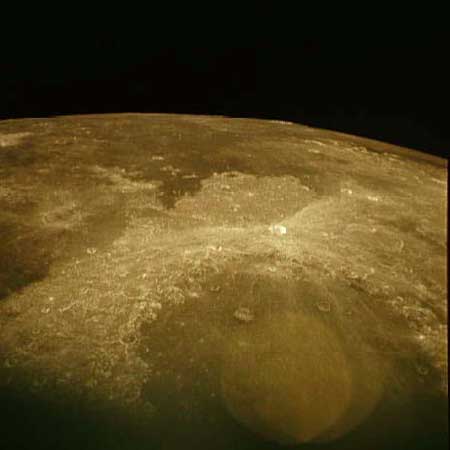
Apollo Image Atlas
AS16-121-19438
www.lpi.usra.edu...
I'll try to get the same area from World Wind, and see what I can find from Smart 1, and try to post them tonight..
EDIT: I can't locate the feature with World Wind.
[edit on 9/7/2006 by anxietydisorder]
From the same region of the Moon where the "bridge?" is located I found another one of those glitches in the 40xx data from NASA Clementine.
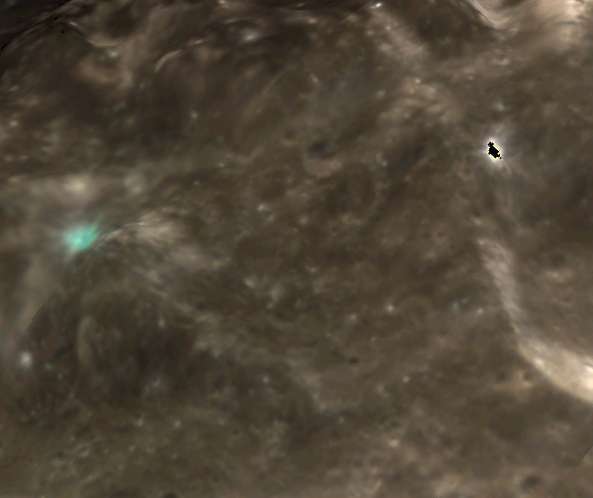
Here's some zooms of what I'm talking about.
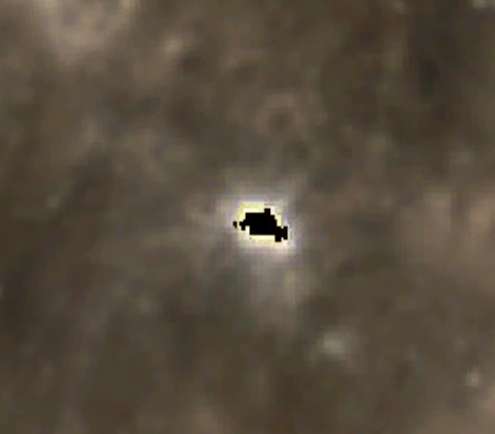
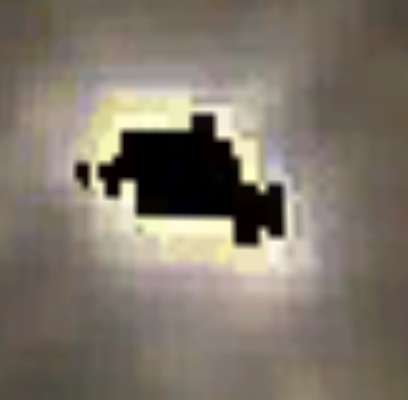
But in 30xx it apears as a white spot.
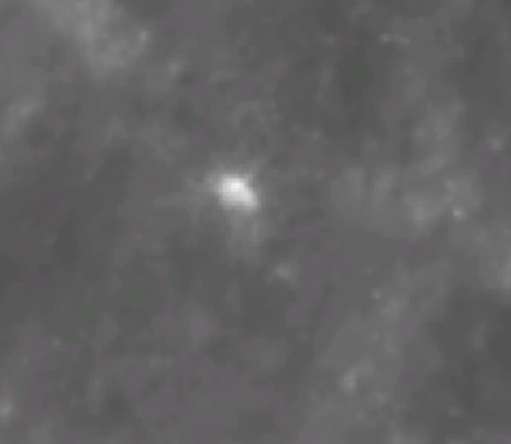
Here's the coordinates if you want to take a look yourself.
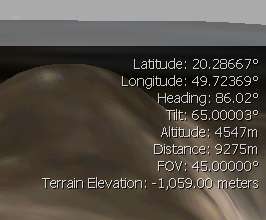
I see these in other areas, and I'd like to know what is causing these glitches.
Any ideas ???

Here's some zooms of what I'm talking about.


But in 30xx it apears as a white spot.

Here's the coordinates if you want to take a look yourself.

I see these in other areas, and I'd like to know what is causing these glitches.
Any ideas ???
hey there all.
ANX they are some pretty strange pics.
Do u have any idea what would cause such a thing to happen>???
I have been thinkin somethin for a while now.\
and that is should we as a team follow a certain direction and then from the follow another???
I would appreciate your responses on this.
For example we could work on the materials needed to withstand the moons environment and things, as we know now there are quakes up there so the building material would have to be something that could withstand such a thing.
Or we could then move on to the coverup with the pics, the dark spots and things or vice versa.
What do u think??
Comon team let me here your thoughts about whether u think we should follow a certain direction within this subject untill we crack it open then we can move on to more.
Omega
ANX they are some pretty strange pics.
Do u have any idea what would cause such a thing to happen>???
I have been thinkin somethin for a while now.\
and that is should we as a team follow a certain direction and then from the follow another???
I would appreciate your responses on this.
For example we could work on the materials needed to withstand the moons environment and things, as we know now there are quakes up there so the building material would have to be something that could withstand such a thing.
Or we could then move on to the coverup with the pics, the dark spots and things or vice versa.
What do u think??
Comon team let me here your thoughts about whether u think we should follow a certain direction within this subject untill we crack it open then we can move on to more.
Omega
I think that is an excellent idea. Its hard to do effective research with all of us going in our own directions constantly. I think we should pick
certain topics, and then devote the necassary time to only researching that specific item. This way we can work together to solve some of these
problems much quicker and more effectively.
Ok, i await the replies from the rest of my team now.
I hopefully will here from you all soon.
Omega
I hopefully will here from you all soon.
Omega
Originally posted by Omega85
hey there all.
ANX they are some pretty strange pics.
Do u have any idea what would cause such a thing to happen>???
I have been thinkin somethin for a while now.\
and that is should we as a team follow a certain direction and then from the follow another???
I would appreciate your responses on this.
For example we could work on the materials needed to withstand the moons environment and things, as we know now there are quakes up there so the building material would have to be something that could withstand such a thing.
Or we could then move on to the coverup with the pics, the dark spots and things or vice versa.
What do u think??
Comon team let me here your thoughts about whether u think we should follow a certain direction within this subject untill we crack it open then we can move on to more.
Omega
Reporting in for duty, sir!
Yes, I agree that we should first focus on what we are looking for. Of course, we can still search for any anomalies that we encounter (which we have seen many already), but if we don't know the possibilities of what the base is created with, how are we going to identify it. I really do believe that the quake information is a good starting point with the construction of bases, as they are going to require being made of materials that can withstand the tension. On the other hand, wouldn't it just be convenient to glue some moonrocks over that material to give the appearance of something common place on the moon. I think what we need to be most attentive to is mistakes. Not our own mistakes (though we should watch for those), but mistakes if indeed there have been some touchups. I've personally never seen any perfect job of photo editing, and I don't think NASA or any other group will be able to do one any easier.
So yeah, all in all, I think structure design is what we should focus on first. I'm somewhat hesitant to use NASA examples of proposed structures, because that could be part of the distraction to lead people searching astray. So I guess we should start building a moonbase in our collective mind and use that as a point of reference when starting.
Hi all,
A very interesting project which already holds substantial photografic evidence..!
I was thinking, what if we tried to get some answers from the persons who actually went to the moon? Astronauts, yeah.
Because Gordon Cooper and Edgar Mitchell already came forward in the Disclosure Project, why not try and get someone to talk from e.g. the Apollo 17 mission?
It´s been 35 years, maybe one of the crew is willing to talk? Then again, how does one contact a real astronaut? Doesn´t seem to be easy, but should not be impossible.
Apollo 17 crew:
Eugene Andrew Cernan, Commander USN
Ronald Ellwin Evans, Commander USN (deceased)
Dr. Harrison Hagen (Jack) Schmitt, Ph.D. civilian
What do you think, should I try to get contact info (on Cooper as well) or do you think it´s a waste of time?
Excuse me sir, but what did you really see on the moon?
A very interesting project which already holds substantial photografic evidence..!
I was thinking, what if we tried to get some answers from the persons who actually went to the moon? Astronauts, yeah.
Because Gordon Cooper and Edgar Mitchell already came forward in the Disclosure Project, why not try and get someone to talk from e.g. the Apollo 17 mission?
It´s been 35 years, maybe one of the crew is willing to talk? Then again, how does one contact a real astronaut? Doesn´t seem to be easy, but should not be impossible.
Apollo 17 crew:
Eugene Andrew Cernan, Commander USN
Ronald Ellwin Evans, Commander USN (deceased)
Dr. Harrison Hagen (Jack) Schmitt, Ph.D. civilian
What do you think, should I try to get contact info (on Cooper as well) or do you think it´s a waste of time?
Excuse me sir, but what did you really see on the moon?
I do not have a lot of time for actual research, I feared as much when I joined, but the topic is so fascinating.
I do however have some VERY excellent graphics programs and a machine to run them. I could probably help in the editing and enhancement of images if that would be any help at all. I even have a program that extrapolates information about the image and produces varied results.
It is all part of one of my duties in Computer Forensics, but I bought the programs myself, so they are mine to use.
Semper
I do however have some VERY excellent graphics programs and a machine to run them. I could probably help in the editing and enhancement of images if that would be any help at all. I even have a program that extrapolates information about the image and produces varied results.
It is all part of one of my duties in Computer Forensics, but I bought the programs myself, so they are mine to use.
Semper
I'd like to see a bit more focus for this project because I don't see it going anywhere at this point. I don't trust the NASA imagery completely
for the simple reason that if they had a base they would mask it out in any pictures released to the public.
I think if any nation on Earth had a lunar base it would be boasted about in the news so that other countries could see how superior they are.
Moon Quakes.....
The Moon does have quakes, but none have been measured on the scale that we have them on Earth. I think the best has been around 5.5, and I don't think a 5.5 would even get me out of bed in the morning.
This is Buzz Aldrin setting up a seismometer in the Sea of Tranquillity.
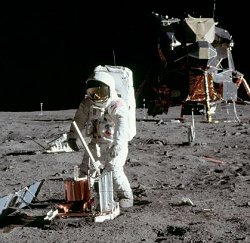
That's a bit of info on Moonquakes, and I don't think they are a real issue.
Due to radiation and the possibility of an impact, I think any base is going to be deep under the surface. A base would only have limited exposure to the surface, such as entrances and observation areas.
I'm spending a lot of time looking for tailings on the surface and the dross left from a mining operation, but so far, nothing...........
I think if any nation on Earth had a lunar base it would be boasted about in the news so that other countries could see how superior they are.
Moon Quakes.....
The Moon does have quakes, but none have been measured on the scale that we have them on Earth. I think the best has been around 5.5, and I don't think a 5.5 would even get me out of bed in the morning.
Between 1969 and 1972, Apollo astronauts placed seismometers at their landing sites around the moon. The Apollo 12, 14, 15, and 16 instruments faithfully radioed data back to Earth until they were switched off in 1977.
There are at least four different kinds of moonquakes: (1) deep moonquakes about 700 km below the surface, probably caused by tides; (2) vibrations from the impact of meteorites; (3) thermal quakes caused by the expansion of the frigid crust when first illuminated by the morning sun after two weeks of deep-freeze lunar night; and (4) shallow moonquakes only 20 or 30 kilometers below the surface.
The first three were generally mild and harmless. Shallow moonquakes on the other hand were doozies. Between 1972 and 1977, the Apollo seismic network saw twenty-eight of them; a few "registered up to 5.5 on the Richter scale," says Neal. A magnitude 5 quake on Earth is energetic enough to move heavy furniture and crack plaster.
science.nasa.gov...
This is Buzz Aldrin setting up a seismometer in the Sea of Tranquillity.

Seismic activity on the Moon is very low, basically insignificant. Due to the lack of plate tectonics, Lunar seismic activity is about a 100 millionth of Earth's, or ~2 x 1010 J/yr (excluding impacts). In eight years of monitoring, a large-but-rare moonquake has not been recorded, but it is possible to have up to 1 x 1014 J/yr if such events were recorded. The largest recorded seismic activities are approximately equivalent to a 4 on the richter scale, with 1-2 being typical.
The lunar seismic activity is usually caused from tidal forces and secondary effects from impacts. Secondary effects includes fresh crater ejecta cracking due to thermal stresses and disruption of slopes with high angles of repose. Other, non-seismic activity includes astronaut activity and impacts (both meteorite and artificial).
The Moon has very low elastic wave propagation losses, and seismic activity is thus clearly registered over long distances. This low attenuation also results in a long half-lives of seismic energy, in the tens of minutes, and the phrase "rang like a bell" after an Saturn upper stage lunar impact. Incidently, this long seismic signature suggests itself as a possible communication device, albeit with bandwidth issues.
There are secondary effects from lunar seismic activity that can create hazards to a presence on the Moon. Because of the excellent wave propagation, seismic activity can create widespread secondary activity, such as crater wall slumping and landslides. Apollo 17 astronauts visited a landslide which probably resulted from the impact that created the Tycho crater, 100 million years ago, and 2000 kilometers away.
www.asi.org...
Moonquakes
Apollo astronauts used seismometers during their visits to the Moon and discovered that the gray orb isn't a totally dead place, geologically speaking. Small moonquakes, originating several miles (kilometers) below the surface, are thought to be caused by the gravitational pull of Earth. Sometimes tiny fractures appear at the surface, and gas escapes.
www.space.com...
A moonquake is the lunar equivalent of an earthquake. They were first discovered by the Apollo astronauts. Moonquakes are much weaker than earthquakes.
Information about moonquakes comes from seismometers placed on the Moon by Apollo astronauts from 1969 through 1972. The instruments placed by the Apollo 12, 14, 15 and 16 functioned perfectly until switched off in 1977.
According to NASA, there are at least four different kinds of moonquakes:
* Deep moonquakes (~700 km below the surface, probably caused by tidal in origin)
* Meteorites impact vibrations
* Thermal quakes (the frigid lunar crust expands sunlight returns after the two week lunar night)
* Shallow moonquakes (20 or 30 kilometers below the surface)
The first three mentioned above tend to be mild; however, shallow moonquakes can register up to 5.5 on the Richter scale. Between 1972 and 1977, twenty-eight shallow moonquakes were observed. On Earth, quakes of magnitude 4.5 and above can cause damage to buildings and other rigid structures.
en.wikipedia.org...
That's a bit of info on Moonquakes, and I don't think they are a real issue.
Due to radiation and the possibility of an impact, I think any base is going to be deep under the surface. A base would only have limited exposure to the surface, such as entrances and observation areas.
I'm spending a lot of time looking for tailings on the surface and the dross left from a mining operation, but so far, nothing...........
Greetings all!!
Great feedback guys
I would also like to welcome HardToGet to the team.
First of all i think the question we have to ask ourselves is WHY?
y would they wanna go there??
Here are some things i have come up with.
Millitary Advantage.
SafeHaven
Tech Advancement.
Observation
Anyone else have any other ideas??
Great feedback guys
I would also like to welcome HardToGet to the team.
First of all i think the question we have to ask ourselves is WHY?
y would they wanna go there??
Here are some things i have come up with.
Millitary Advantage.
SafeHaven
Tech Advancement.
Observation
Anyone else have any other ideas??
Well for one thing they could use Moon bases for research without being disturbed by nosy third parties. It´s the perfect hideout.
Also those bases could be used as a terminal for voyages within the galaxy and testing "hyperdrives". If only 10% of what is out there is true, we are already well into space with recovered alien technology.
What better place to use than the moon as a base for these activities?
I´ll go through the thread to see all additions to the project to see if I can add some pictures that are not already posted...
Also those bases could be used as a terminal for voyages within the galaxy and testing "hyperdrives". If only 10% of what is out there is true, we are already well into space with recovered alien technology.
What better place to use than the moon as a base for these activities?
I´ll go through the thread to see all additions to the project to see if I can add some pictures that are not already posted...
If the Government is controlled then where else could they go?
With the advent of things like Google Earth, this little rock we all sit on has suddenly become much smaller and much more visible. This was all predicted if that is the case.
If one makes the Grand Leap that the Bildenbergers (sp?), the Imminati or some other shadow organization is controlling most if not all aspects of our life, culture and economy, then they would as a result need a "base" of sorts.
I have reviewed, and even enhanced many of the pictures on here and I can not see where any thinking individual would not conclude that there are FAR too many unexplainable incidents happening on the moon.
Coincidence only goes so far, then you have to start working on the theory that it goes WAY beyond coincidence.
With that in mind, take the fact that over 80% of all the pictures taken by the Government on the Clementine Mission are still classified, and you have the makings of a real "who done it."
The biggest and baddest question for me is still; Why would the Government feel the need to classify pictures of the back side of the moon?
I have written several letters and emailed my tail off and of course I have gotten no response.
Oh well, still working on the pictures all of us have supplied. I hope to have some enhanced ones up on here at the end of the week.
This is a cool program that takes the picture and using the computer program literally "fills' in the parts of a picture that have been smudged or blacked out.
Well off to work people...
Semper
With the advent of things like Google Earth, this little rock we all sit on has suddenly become much smaller and much more visible. This was all predicted if that is the case.
If one makes the Grand Leap that the Bildenbergers (sp?), the Imminati or some other shadow organization is controlling most if not all aspects of our life, culture and economy, then they would as a result need a "base" of sorts.
I have reviewed, and even enhanced many of the pictures on here and I can not see where any thinking individual would not conclude that there are FAR too many unexplainable incidents happening on the moon.
Coincidence only goes so far, then you have to start working on the theory that it goes WAY beyond coincidence.
With that in mind, take the fact that over 80% of all the pictures taken by the Government on the Clementine Mission are still classified, and you have the makings of a real "who done it."
The biggest and baddest question for me is still; Why would the Government feel the need to classify pictures of the back side of the moon?
I have written several letters and emailed my tail off and of course I have gotten no response.
Oh well, still working on the pictures all of us have supplied. I hope to have some enhanced ones up on here at the end of the week.
This is a cool program that takes the picture and using the computer program literally "fills' in the parts of a picture that have been smudged or blacked out.
Well off to work people...
Semper
Greetings all.
Semper it is indeed interesting that those pics are still classified, abit too interesting if u know what i mean .
I agree with hard to get that it would be the perfect hideout for covert projects and operations but how would they keep alive up there??
would they have supplies transported to them or how would they do it??
Im curiouse about this because they would need somesort of sustinance while they were up there ,
For research purpouses i think it would be good if we could all do abit of digging and find out which building materialls would serve good in a environment with quakes and if possible zero gravity.
I dont know but i was thinking , does anyone know what Bomb shelters are made of??
Also i was thinking about the energy issue. obviouslyt they would need electricity or something like that to live up there but my question is how would they do it??
I dont know if it could be sollar powered since it is called "the dark side of the moon"
UNLESS if they are using sollar generation they are camoflaging the panells somehow.
not sure exactly but it would be good to research this project systematicly because as we all know everything is made up of systems from turning ur car on to switching a lamp on.
Perhaps for the building to be able to withstand these quakes i have come up with some conclusions about this. feel free to add to these as i am researching this.
1) Underneith the structure there is some sort of Dampener to diminish vibrations and reverberating waves.
2) These buildings walls are extremely thick and the buildings themselves are dug very deep into the moons crust .
3) As we were talking about earlier , are there some places on the moon that these quakes do not happen?? If so where are they as they would probably be the best location for a series of buildings .
I mean , when you think about it .
There is no gravity on the moon and so im thinkin about newtons law here, i think its his second law goes like this .
A object travelling at a certain velocity will continue travelling at the vellocity unless acted on by an opposing or opposite force.
Therefore if there was an earthquake and these buildings were shock and some pieces became loose or broke of from the main structure, one would presume that these fragments would keep on travelling and eventually drift into space. Correct me if im wrong but this is just a thought .
On another note , i was talking about ways they would produce energy up there and i found something very interesting about a gas that is found on the moon .
There is nearlly no trace of this element on earth BUT on the moon , it is in abundance .
I also found this interesting article on it .
From this site
I found this interesting and i would recomend that site to you groovey people to have a read of .
I think that looking at this from a systematic point of veiw is a good idea and with that we can disect and rip the system apart then find out more about its sub systems, i hope that makes sence lol.
Let me know your thoughts about this as i would greatly appreciate it .
Thanks
Omega
[edit on 17/7/2006 by Omega85]
[edit on 17/7/2006 by Omega85]
Semper it is indeed interesting that those pics are still classified, abit too interesting if u know what i mean .
I agree with hard to get that it would be the perfect hideout for covert projects and operations but how would they keep alive up there??
would they have supplies transported to them or how would they do it??
Im curiouse about this because they would need somesort of sustinance while they were up there ,
For research purpouses i think it would be good if we could all do abit of digging and find out which building materialls would serve good in a environment with quakes and if possible zero gravity.
I dont know but i was thinking , does anyone know what Bomb shelters are made of??
Also i was thinking about the energy issue. obviouslyt they would need electricity or something like that to live up there but my question is how would they do it??
I dont know if it could be sollar powered since it is called "the dark side of the moon"
UNLESS if they are using sollar generation they are camoflaging the panells somehow.
not sure exactly but it would be good to research this project systematicly because as we all know everything is made up of systems from turning ur car on to switching a lamp on.
Perhaps for the building to be able to withstand these quakes i have come up with some conclusions about this. feel free to add to these as i am researching this.
1) Underneith the structure there is some sort of Dampener to diminish vibrations and reverberating waves.
2) These buildings walls are extremely thick and the buildings themselves are dug very deep into the moons crust .
3) As we were talking about earlier , are there some places on the moon that these quakes do not happen?? If so where are they as they would probably be the best location for a series of buildings .
I mean , when you think about it .
There is no gravity on the moon and so im thinkin about newtons law here, i think its his second law goes like this .
A object travelling at a certain velocity will continue travelling at the vellocity unless acted on by an opposing or opposite force.
Therefore if there was an earthquake and these buildings were shock and some pieces became loose or broke of from the main structure, one would presume that these fragments would keep on travelling and eventually drift into space. Correct me if im wrong but this is just a thought .
On another note , i was talking about ways they would produce energy up there and i found something very interesting about a gas that is found on the moon .
There is nearlly no trace of this element on earth BUT on the moon , it is in abundance .
I also found this interesting article on it .
From this site
Researchers and space enthusiasts seehelium 3 as the perfect fuel source: extremely potent, nonpolluting, withvirtually no radioactive by-product. Proponents claim its the fuel ofthe 21st century.
I found this interesting and i would recomend that site to you groovey people to have a read of .
I think that looking at this from a systematic point of veiw is a good idea and with that we can disect and rip the system apart then find out more about its sub systems, i hope that makes sence lol.
Let me know your thoughts about this as i would greatly appreciate it .
Thanks
Omega
[edit on 17/7/2006 by Omega85]
[edit on 17/7/2006 by Omega85]
It would have to be some sort of Nuclear Power, but with Nuclear power plants small enough to power a sub, that should pose no difficulty.
As for provisions, well "satellites" are launched almost everyday. Who really knows what is the payload or destination?
The Moon has gravity, approximately 1/6 of the earths.
Semper
As for provisions, well "satellites" are launched almost everyday. Who really knows what is the payload or destination?
The Moon has gravity, approximately 1/6 of the earths.
Semper
new topics
-
Let's talk planes.
General Chit Chat: 9 minutes ago -
January 6th report shows disturbing trend (nobody is shocked)
US Political Madness: 1 hours ago -
Inexplicable military simulation - virtual reality showdown in the night..
The Gray Area: 2 hours ago -
The Truth about Migrant Crime in Britain.
Social Issues and Civil Unrest: 3 hours ago -
Trudeau Resigns! Breaking
Other Current Events: 5 hours ago -
Live updates: Congress meets to certify Trump's presidential election victory
US Political Madness: 6 hours ago -
Gravitic Propulsion--What IF the US and China Really Have it?
General Conspiracies: 6 hours ago -
Greatest thing you ever got, or bought?
General Chit Chat: 6 hours ago
top topics
-
Trudeau Resigns! Breaking
Other Current Events: 5 hours ago, 22 flags -
Live updates: Congress meets to certify Trump's presidential election victory
US Political Madness: 6 hours ago, 12 flags -
January 6th report shows disturbing trend (nobody is shocked)
US Political Madness: 1 hours ago, 10 flags -
OK this is sad but very strange stuff
Paranormal Studies: 17 hours ago, 9 flags -
The Truth about Migrant Crime in Britain.
Social Issues and Civil Unrest: 3 hours ago, 8 flags -
Gravitic Propulsion--What IF the US and China Really Have it?
General Conspiracies: 6 hours ago, 7 flags -
Greatest thing you ever got, or bought?
General Chit Chat: 6 hours ago, 3 flags -
Let's talk planes.
General Chit Chat: 9 minutes ago, 1 flags -
Inexplicable military simulation - virtual reality showdown in the night..
The Gray Area: 2 hours ago, 0 flags
active topics
-
Gravitic Propulsion--What IF the US and China Really Have it?
General Conspiracies • 8 • : ARM19688 -
January 6th report shows disturbing trend (nobody is shocked)
US Political Madness • 5 • : NeedInfo -
Let's talk planes.
General Chit Chat • 0 • : Shoshanna -
Trudeau Resigns! Breaking
Other Current Events • 54 • : Flyingclaydisk -
Meta Llama local AI system is scary good
Science & Technology • 41 • : glend -
Sorry to disappoint you but...
US Political Madness • 29 • : Kaiju666 -
The Truth about Migrant Crime in Britain.
Social Issues and Civil Unrest • 11 • : putnam6 -
Greatest thing you ever got, or bought?
General Chit Chat • 20 • : lilzazz -
-@TH3WH17ERABB17- -Q- ---TIME TO SHOW THE WORLD--- -Part- --44--
Dissecting Disinformation • 3952 • : AianawaQ1320 -
Live updates: Congress meets to certify Trump's presidential election victory
US Political Madness • 17 • : Dalamax
